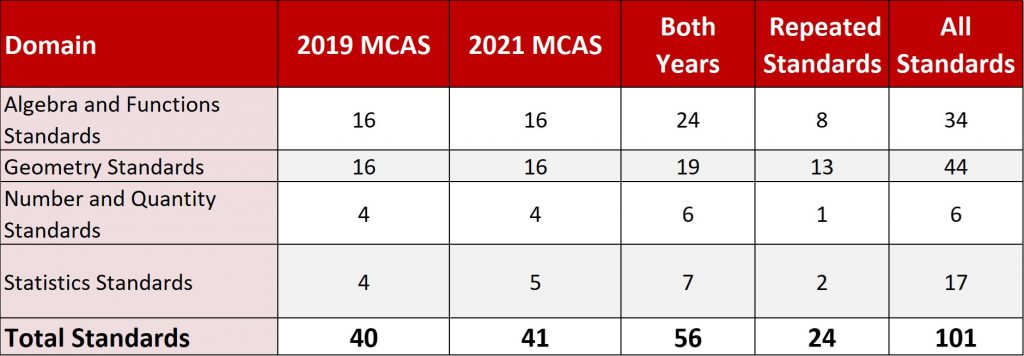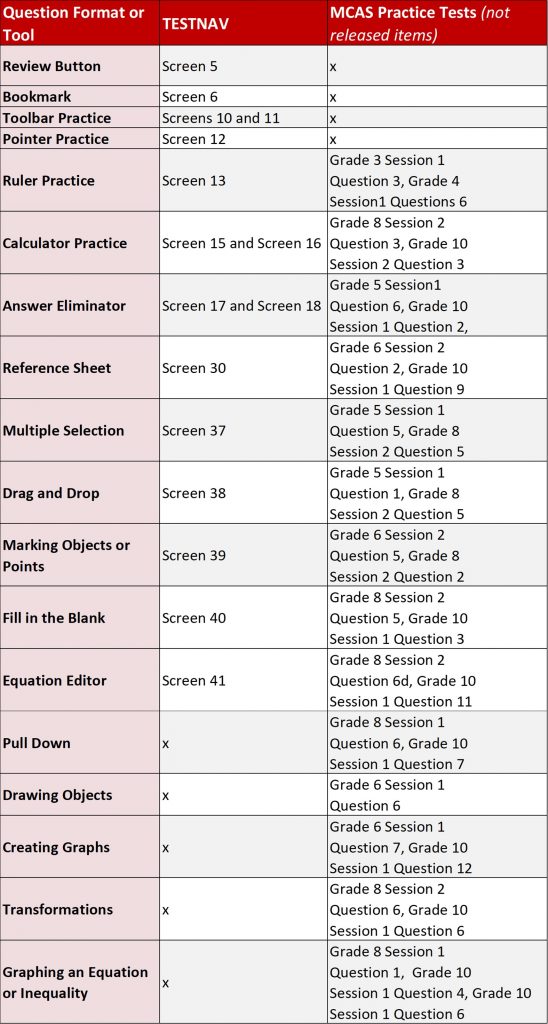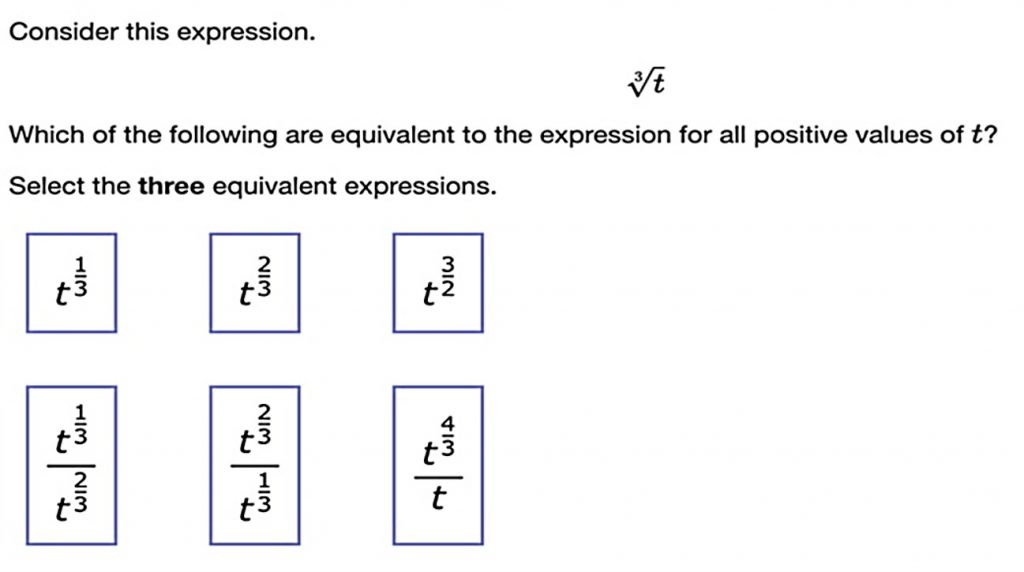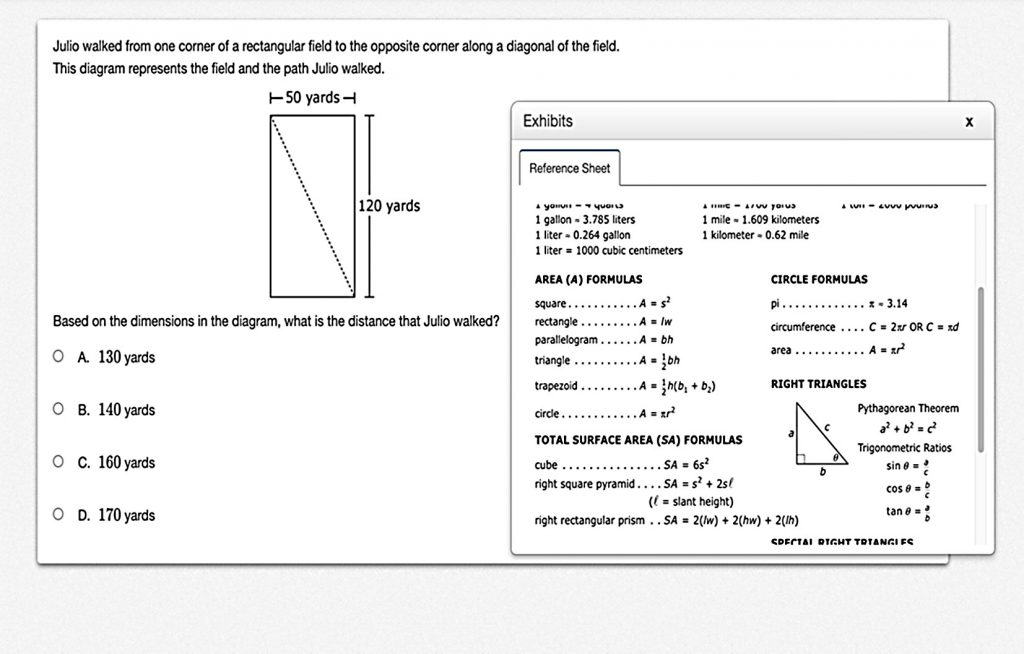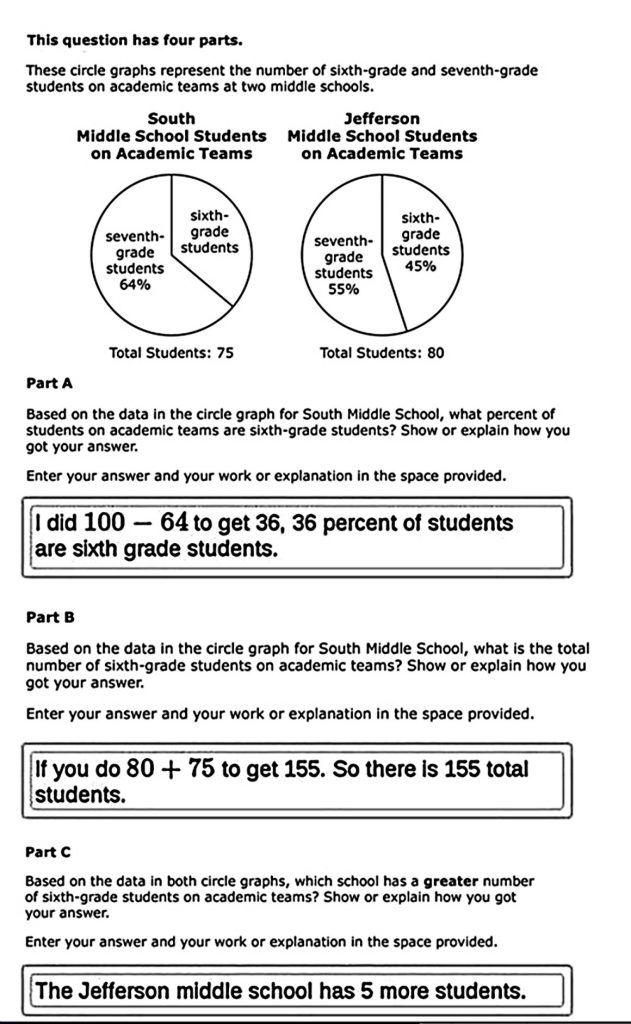by Joan Reissman
New Standards, Old Formats
JFY strategies help students succeed
MCAS is back and the 10th grade math test will be here before we know it.
JFYNetWorks has been helping prepare students for MCAS tests for two decades. Working on the curriculum standards throughout the year is the best preparation for MCAS, but we have a few homestretch strategies to help students do their very best on the math MCAS May 17.
Now that we have two years of Next Generation MCAS 2.0 tests behind us, we have a better idea of what students will be responsible for. The 2018 Legacy test was the last one that was based on the old 2000 curriculum standards. In 2019 the new 10th grade test transitioned to the revised Mathematics standards that were adopted in 2017. This transition created a significant change in the distribution of domains. MCAS 2.0 has a much higher proportion of algebra and geometry than the old test. Here’s the distribution in 2019 and 2021:
The distribution of domains in the two years is almost identical, so we now have an established pattern. Both the standards tested and the number of questions each year are very similar, as you can see in the chart below. You can also see that only 24 standards out of the total 101 10th grade standards were repeated both years. Now that we know which standards are likely to be tested, we can focus on these standards for a concentrated review and refreshment of skills. Since MCAS questions are taken directly from the state standards, a year-end MCAS intensive is a good way to review the whole year.
Covid Interruptions
We all know that last year was not a normal year. The interruptions and instability made things difficult for everybody. Although teachers and students did the best they could under difficult circumstances, student retention of previous years’ material suffered. That unfinished learning, or learning loss, creates a need to review past standards, not only to do well on the MCAS but to catch up to grade level. For teachers this means reviewing essential concepts from past years along with the normal focus on grade level content. Bridging past years’ skills through acceleration will get students where they need to be.
Test Tech
One important way to prepare students for MCAS is to make sure they are comfortable with the test’s technology. This is especially important for 10th graders. Since there was no MCAS in 2020, and there is no 9th grade math MCAS, it’s likely that this year’s 10th graders haven’t taken the computer-based test or seen MCAS at all since 2019. Today’s students are tech savvy. They have grown up with technology, but even if a student has 1,000 followers on TikTok, that does not mean she is familiar with the tech tools on the MCAS test. There are many methods of answering questions on the test that are not used on the average internet site. MCAS is not Instagram, TikTok, or Twitter. It’s not intuitive. It’s not user-friendly. It has its own peculiar clunky interface.
Resources
You can help students prepare for MCAS by going to http://mcas.pearsonsupport.com/. This site has many helpful resources. The three most useful areas of the site are the TestNav 8 tutorial, the MCAS practice tests and the MCAS released items. Students should be required to use TestNav and take the practice test to get a feel for the navigation. Then they can practice the released items right before the test. They can take any of the tests more than once, and there are four math tests for grades 3-8 and two tests for grade 10.
TestNav (in the Practice Tests section) is the best way to make sure your students are familiar with all the available tools and question formats. Practice with your students on TestNav as a group. Start with a review of test navigation. Go over signing in and out, moving backwards and forwards in the test, and submitting final answers. Make sure you demonstrate all technology-enhanced formats. Preparation is the key to building confidence. You don’t want students to make mistakes because they are unfamiliar with the format. Students should be thinking about content not technology-don’t let them risk being flustered.
Use the following chart to identify practice for tools and formats on the DESE site http://mcas.pearsonsupport.com/
More Tools
Make sure students understand how to manipulate all tools and formats in the above chart. Use the practice test section for reinforcing the technology. Save the released items for test practice.
There are some other general tips for using technology tools on MCAS 2.0. Teach students how to use the bookmark tool. Remind them not to overuse bookmarking or it will not be useful. Students can skip questions by bookmarking them and returning before submitting their answers. If a student spends time working on a question, she should put in an answer. It’s better to put in an answer and bookmark it if she doesn’t feel confident about the answer. She can also use the review button at any time before submission to return to a particular question. When she is finished, she can submit the section. Answers cannot be changed after clicking ”submit section.“
Also remind students that just because a tool is available on one question, that does not mean it is available for every question. The most important tool that is not always available is the calculator. Many students depend on calculators, but they will only be able to use it on certain questions. The calculator is only available on the second section of the test for grades 7,8, and 10.
The tool that is most unfamiliar to students is the equation editor. The equation editor becomes more complex in the upper grades. Make sure students understand everything that is available in the equation editor for their grade, and that they know how to edit or change the content. There are different equation editors for grades 3-5, 6-8 and 10.
Reading Required
Math requires reading Even though this is a math test, it is more important than ever to read carefully. Students need to be especially careful about multiple select questions. Some questions will ask students to select two or three choices. If a student chooses more than the required amount, a warning sign pops up. But if the student chooses less than the required amount, there is no warning.
Here is an example of a multiple select question:
Another important tool is the reference sheet. The formula page is your friend. This handy sheet is your best pal during the exam for geometry and measurement questions. Whenever you are doing a geometry or measurement question, click on the exhibits icon in the middle of the right side of the screen to double check your geometry formula or measurement equivalencies. You might also be able to answer the first part of some constructed-response geometry questions by simply plugging in the formula, even if you can’t answer the rest of the question. A partial answer gets some points. Don’t throw points away by forgetting to use this valuable tool.
This example from the 10th grade test shows how easy it is to answer a question using the reference sheet that’s on the MCAS test.
Constructed Response
If you ask a student what he doesn’t like about MCAS, the answer will probably be the constructed response questions. Remind students not to leave these questions blank. Show them that answering some of the question is an easy way to earn valuable points. The first two parts of a constructed response question are usually pretty straightforward. Even if the answer isn’t perfect, the student will still get points for answering part of the question.
Teachers can practice a constructed response as group. Choose an example from the DESE Student Work section. Go to https://www.doe.mass.edu/mcas/student/default.html. You will see six years of constructed response examples in all grades. Take one example and do the problem as a class. Then show the answers that received scores from 0-4. You can hide the score and have students vote on the grade. You can also do a constructed response question together and then let students grade responses on their own. This exercise builds confidence so students can see that answering part of the question still helps them earn valuable points. In the example below (score 2) you can see that the student made mistakes but still received points.
Pep Talk
What I say to students is this:
MCAS doesn’t have to be a negative experience. Preparation can be a big help. You’ve been learning math all year and you’re ready for this. You’re not going to see any math problems that you haven’t seen before—especially if you’ve been through the JFYNet intensive. Maybe you’d rather watch TikTok than prepare for a test, but think how great you’ll feel when you get a good score. Review last year’s material, get comfortable with the format, and feel confident that you have done the necessary preparation. Test day will be a stroll in the park.
Note: JFYNetWorks will be featuring weekly tips for the MCAS tests. Watch this space.
Joan Reissman, the MCAS Maven, is a JFYNetWorks Learning Specialist.
Other posts authored by Joan can be found here.
HOW ARE WE DOING? In our pursuit to serve up content that matters to you, we ask that you take a couple of minutes to let us know how we’re doing? Please click here to be navigated to our JFYNet Satisfaction Survey. Thank you!



